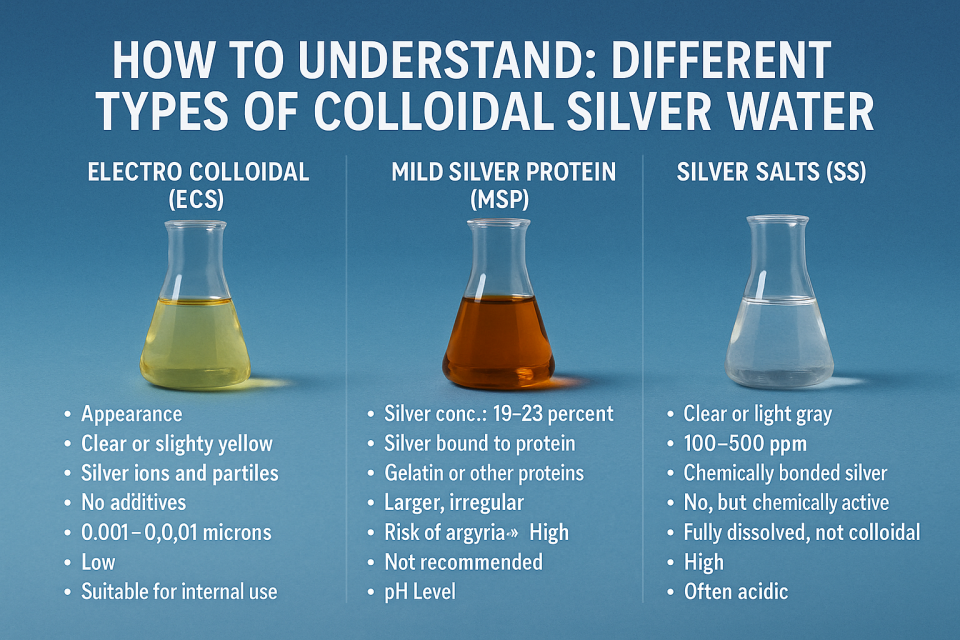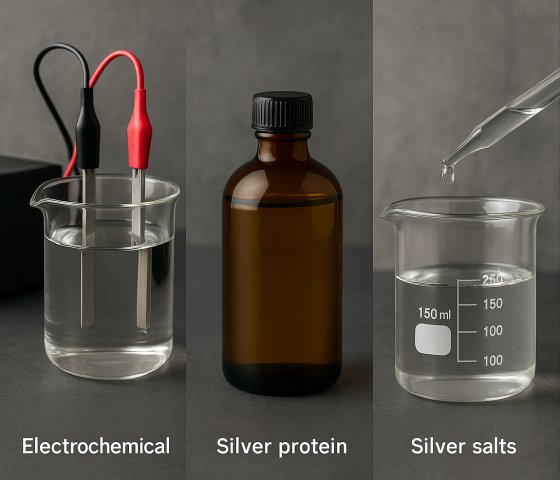Colloidal silver has long been promoted as a natural remedy with antibacterial, antiviral, and antifungal properties. While it has a well-documented history of use, confusion persists around what colloidal silver actually is, especially since the term has been used to describe several distinct types of silver-based products. Understanding the differences is essential to avoid side effects and to ensure you’re using a product that is both safe and effective.
What Is “Colloidal Silver”?
The term “colloidal silver” is commonly used today to describe liquid products that contain silver particles, silver ions, and water. However, in both historical and scientific contexts, “colloidal silver” has referred to three primary types of substances:
- Electro Colloidal Silver (ECS)
- Mild Silver Protein (MSP)
- Silver Salts (SS)
Each of these differs significantly in how it’s made, how it behaves in the body, and how safe or effective it is for medicinal use.
- Electro Colloidal Silver (ECS)
Electro-colloidal silver is considered the “true” colloid by most natural health professionals. It is created using a low-voltage electric current passed through pure silver electrodes submerged in distilled or deionized water. This process causes microscopic silver particles and ions to become suspended in the water.
Key Features:
- Appearance: Transparent and colorless or with a slight yellow tint
- Silver Content: Usually 5–10 ppm (parts per million)
- Particle Size: Ideally 0.001 to 0.01 microns
- Composition: 5–25% particles, 75–95% ions
- Additives: None—pure silver and distilled water
- pH: Close to 7 (neutral)
Benefits:
- Non-toxic when made and used correctly
- Easily absorbed by the body
- Least likely to cause argyria (a rare condition where skin turns blue-gray)
Considerations:
- Needs to be made or sourced carefully, as quality varies widely
- Most negative press about “colloidal silver” actually refers to other types
- Mild Silver Protein (MSP)
MSP products are made by chemically bonding silver to a protein molecule (typically gelatin) using silver nitrate and other chemicals. This stabilizer helps prevent the silver particles from clumping and settling out.
Key Features:
- Appearance: Dark amber or brown, often cloudy
- Silver Content: 19–23% silver
- Additives: Gelatin or other protein stabilizers
- pH: Variable
Benefits:
- Longer shelf life due to stabilizers
- Historically used in some pharmaceutical products
Risks:
- High risk of argyria with overuse
- Poor absorption compared to true colloids
- Can cause allergic reactions due to protein content
- Silver Salts (SS)
Silver salts include compounds like silver nitrate, silver chloride, silver iodide, and silver phosphate. These are made chemically or electrochemically and dissolve fully in water, acting more like a chemical than a true colloid.
Key Features:
- Appearance: Typically colorless or light gray
- Silver Content: High—100 to 500 ppm
- Additives: Often none, but still chemically reactive
- pH: Often acidic
Benefits:
- Potent antimicrobial properties
- Used topically in burn creams and eye drops
Risks:
- Highly irritating to tissues when ingested
- Not safe for internal use
- Most medical “horror stories” about colloidal silver relate to these forms
Ideal Colloidal Silver Characteristics
Based on research by Gibbs (1990) and Key (2000), the ideal colloidal silver product should:
- Contain only pure silver and distilled water
- Be clear and colorless, indicating small, uniform particles
- Have a neutral pH (~7)
- Be free of stabilizers or proteins
- Be composed of both silver ions and small particles for maximum effectiveness
Some experts suggest calling such a product “ionic silver water” or “electrically isolated silver,” but “colloidal silver” remains the most widely recognized term.
DIY and Consumer Tips
Because there’s no industry standard or government oversight for colloidal silver products, consumers must be proactive:
- Request lab reports from manufacturers, including data on ppm, pH, and particle size.
- Avoid products with color, unless you understand the reason for the hue.
- Steer clear of protein-based or chemically made products unless directed by a health professional.
- Consider making your own colloidal silver using a home generator—many experienced users do this and test the results for quality.
Summary Comparison
| Feature | Electro Colloidal Silver (ECS) | Mild Silver Protein (MSP) | Silver Salts (SS) |
| Appearance | Clear or light yellow | Dark amber, often cloudy | Clear or light gray |
| Silver Concentration | 5–10 ppm | 19–23% | 100–500 ppm |
| Composition | Silver ions & particles | Silver bound to protein | Chemically bonded silver |
| Additives | None | Gelatin or other proteins | None, but chemically active |
| Particle Size | 0.001–0.01 microns | Larger, irregular | Fully dissolved, not colloidal |
| Risk of Argyria | Low | Moderate to High | High |
| Suitable for Internal Use | Yes (when pure and tested) | No (not recommended) | No |
| pH Level | Neutral (around 7) | Variable | Often acidic |
Colloidal silver can be a powerful health ally, but only if you know what you’re using. The true therapeutic benefits of colloidal silver lie in high-quality electro-colloidal products that are pure, properly produced, and used responsibly. By understanding the differences between ECS, MSP, and SS, consumers can make informed decisions and avoid the side effects tied to inferior products.
References:
- Gibbs, M. (1990). Silver in Medicine: Historical and Clinical Review.
- Key, B. (2000). Colloidal Silver: The Natural Antibiotic.
- Natural Immunogenics. Silver Kill Test Comparisons.
- U.S. Food and Drug Administration (FDA). (2000). Consumer Advisory: Colloidal Silver Products.
- Barillo, D.J. & Marx, D.E. (2014). “Silver in medicine: A brief history BC 335 to present.” Burns, 40(S1), S3–S8.
- Rowland, Wayne & Herb Roi Richards. (2014). Silver Water Colloidal: Clinical Use and Commentary.

